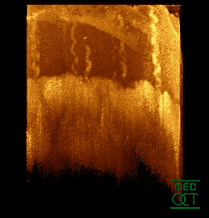CCC you
Wednesday, August 8th, 2007just an announcement: The CCC camp starts today at Finowfurt. Here the site with an introductory video by Tim Pritlove et al.
randformblog on math, physics, art, and design |
just an announcement: The CCC camp starts today at Finowfurt. Here the site with an introductory video by Tim Pritlove et al.
Just some images from an interesting architectural application of solar cells.
(more…)
The Institute for Advanced Technologies in the Humanities at the University of Virginia recently presented at a press conference in Rome the virtual city project rome reborn 1.0:
Visitors to virtual Rome will be able to do even more than ancient Romans did: They can crawl through the bowels of the Colosseum, filled with lion cages and primitive elevators, and fly up for a detailed look at bas-reliefs and inscriptions atop triumphal arches.
“This is the first step in the creation of a virtual time machine, which our children and grandchildren will use to study the history of Rome and many other great cities around the world,” said Bernard Frischer of the University of Virginia, who led the project.
The $2 million simulation will be used by scientists to run experiments – such as determining the crowd capacity of ancient buildings – and as a scholarly journal that will be updated at each new discovery of one of Rome’s marvels.
(citation from physorg)
According to Heise online the german government in its function as Presidency of the European Council wants to come to an agreement for the new EU passports before the end of July. This may spur the discussion about finger prints in passports on an european level.
->for DIY directions of how to make an artificial fingerprint mask from an arbitrary fingerprint see computer magazin c’t page 102 (unfortunately in german and not online)
I am aware of the fact that it may be funny if a mathematical physicist speaks about theatre.

One of the interesting unknowns is the question wether the brain acts -at least partially- as a quantum computer. The discussion seems to have gotten again a boost – considering the number of conferences organized on this issue, like the already mentioned January swiss conference or the conference Quantum Mind organized by the center for consciousness and the Uni Salzburg or the conference Toward a Science of Consciousness 2007 in Budapest organized by the Hungarian Cognitive Science Foundation.
A reason for this boost may partially be due to the fact that optical imaging and mapping techniques are vastly improving. Optical imaging techniques are popular since they provide a noninvasive method to study the brain, like e.g. in experiments by Ed Boyden et al. were neurons were photostimulated via Channelrhodopsin-2 and other proteins (see also here) (where I have to say that the in the article mentioned lentiviral gene delivery sounds rather scary to me) or e.g. the interesting optical techique of OCT-Optical coherence tomography (or LMU OCT) using interferences of light with short coherence length.
OCT can currently be only used for investigating thin layers like skins, as can be seen at the above crumpled scan of a fingertip or – whats more important e.g. for investigating the retina – a thin layer of neural cells that lines the back of the eyeball.
Using a new way of organizing light pulses (FDML) researchers were able to provide rapid, high-resolution 3-D images of the retina as was presented on the Conference on Lasers and Electro-Optics, Quantum Electronics and Laser Science Conference by the Optical Society of America.
Why is the retina and the layers around it particularily interesting? Because the retina is capable to transmit a signal of a few photons, leaving enough space for quantum mechanical considerations, like in the famous discussion in here, where – even if this seems unrelated – e.g. the true size of a graviton may play a role.
As it seems the current believe is that brains probably do not act as quantum computers mainly due to the “disturbancies” of the information by the surroundings, which leads to decoherence – a general problem also for technical quantum computers. Among others there is some hope to get better results with regard to disturbances with the help of topological quantum theories, which can be imagined (very very loosely speaking) as quantum versions of solitons, i.e. waves which are very stable.